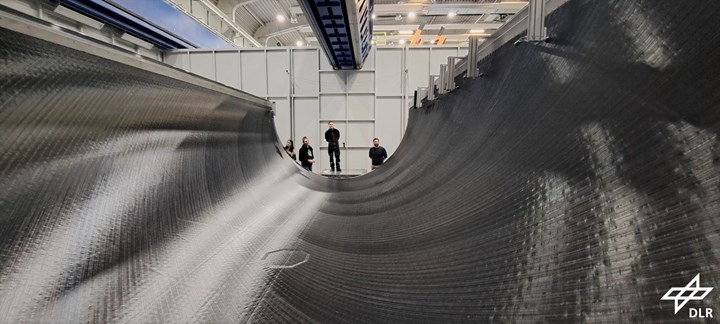DLR completes MFFD upper shell skin layup
Eight-meter-long CFRTP fuselage skin was achieved via laser-heated in-situ consolidation, with stringers, frames and cleats to be welded.
In Jan. 2023, the DLR Institute of Structures and Design (DLR, Augsburg, Germany) completed the layup of the full-scale, 8-meter-long fuselage skin for the Multifunctional Fuselage Demonstrator’s (MFFD) upper shell.
Funded by Clean Aviation, the welded MFFD fuselage demonstrator is said to represent the largest known aeronautical structure made of thermoplastic composites. Begun in 2014, project partners Airbus (Toulouse, France), Aernnova Aerospace (Miñano, Spain) and Premium AEROTEC (Augsburg, Germany) seek to demonstrate significant weight reduction, while cutting back waste and cost (see “Moving forward on the Multifunctional Fuselage Demonstrator (MFFD)”).
The upper shell skin, a Cetex TC1225 low-melt polyaryletherketone (LM-PAEK) carbon fiber thermoplastic prepreg from Toray Advanced Composites (Nijverdal, Netherlands), was placed on a TC1225 LSP film which was impregnated with the same LM-PAEK matrix. An LDM diode laser provided by Laserline GmbH (Mülheim-Kärlich, Germany) and the multi-tow laying head from AFPT GmbH (Dörth), performed laser-heated in-situ consolidation to achieve a smooth skin on the upper shell’s Grunewald GmbH & Co. KG (Bocholt) placement tool. (Watch this video for a visual of the MFFD upper shell production).
“Our placement end-effector with three parallel ½-inch tows has a theoretical throughput of about 4.4 kilograms/hour which corresponds to a production time of 32 hours,” Dominik Deden, senior expert on thermoplastic AFP at DLR, says. “For an industrialized production the number of parallel tows would be increased to meet the goal of 100 aircraft per month. In general, in-situ consolidation avoids vacuum bagging and all related tasks which otherwise can account for up to 40% of the lead time for panel production.”
Production of the test shell was originally completed in April 2022 with the integration of the upper shell’s sixth frame. Moving forward, stringers delivered by Aernnova Aerospace will be integrated via continuous ultrasonic welding, and frames and cleats delivered by Premium AEROTEC will be resistance welded. Read “Thermoplastic composites welding advances for more sustainable airframes” for additional details on what comes next for the upper shell skin.
Related Content
-
Protecting EV motors more efficiently
Motors for electric vehicles are expected to benefit from Trelleborg’s thermoplastic composite rotor sleeve design, which advances materials and processes to produce a lightweight, energy-efficient component.
-
Cycling forward with bike frame materials and processes
Fine-tuning of conventional materials and processes characterizes today’s CFRP bicycle frame manufacturing, whether in the large factories of Asia or at reshored facilities in North America and Europe. Thermoplastic resins and automated processes are on the horizon, though likely years away from high-volume production levels.
-
Materials & Processes: Composites fibers and resins
Compared to legacy materials like steel, aluminum, iron and titanium, composites are still coming of age, and only just now are being better understood by design and manufacturing engineers. However, composites’ physical properties — combined with unbeatable light weight — make them undeniably attractive.

















